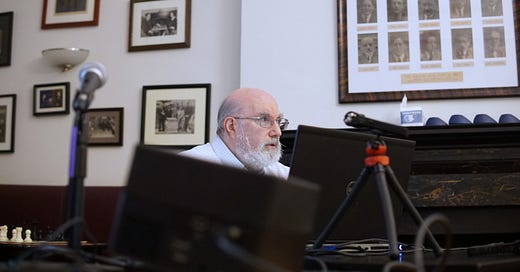The Marshall Spectator

In This Issue:
From The Skittles Room
Endgame Corner, by IM Silas Lund
The Marshall Swindle, by Dr. Frank Brady
Recent Game Submissions
Chess Toons
En Passant
Problem of the Week
Editor's Note
Welcome back, fellow chess players, to this edition of the Marshall Chess Club's fortnightly bulletin, The Marshall Spectator.
Last Tuesday On May 23 we hosted a conversation with ICCF GM and World Correspondence Champion Jon Edwards on the impact of Artificial Intelligence on Correspondence Chess. The event was well attended and sparked many interesting questions and lively discussions about the future of chess. If like me, you were unable to attend the event you can watch the lecture and Q and A in its entirety here.
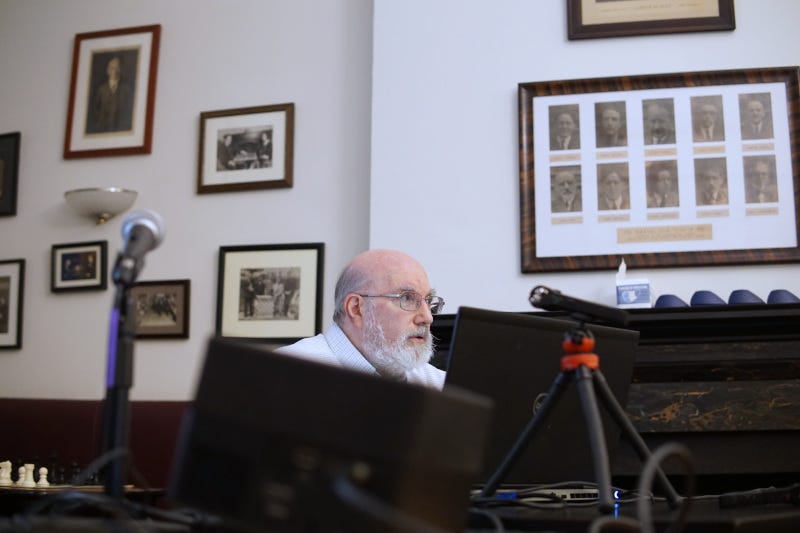
Looking further ahead, on June 6 we will be having a lecture and Simul with GM Sam Shankland. Please be sure to register in advance as this event is likely to sell out quickly.
We would also like to remind members to take advantage of the complimentary game analysis by Grandmaster Raven Sturt at our club each Thursday at the club from 5-7pm. GM Sturt will analyze games of any member lucky enough to walk by his table holding a score sheet.
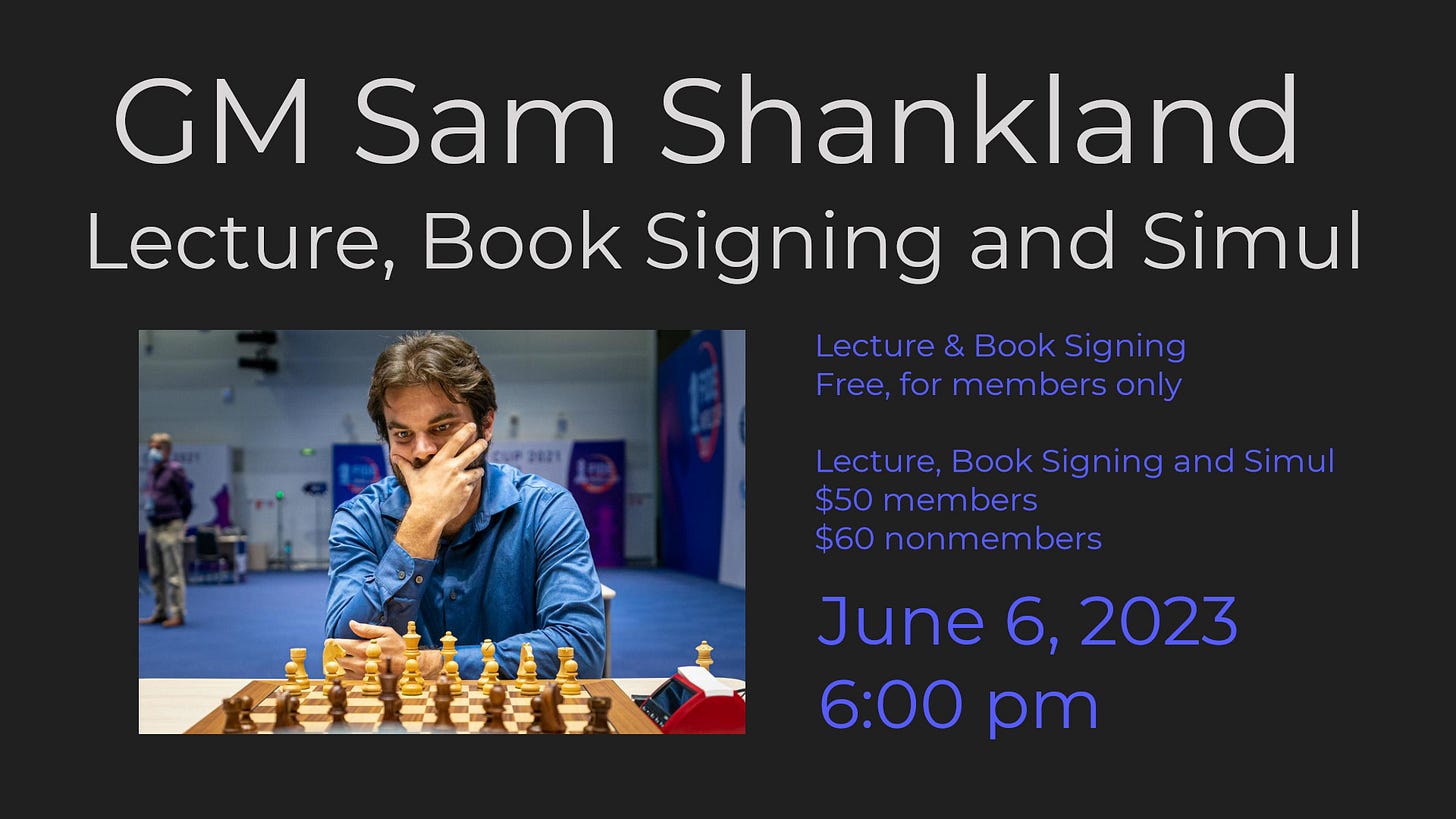
For more details about these events or to register in advance please visit our website. We look forward to seeing you soon.

In the last few weeks, we have had a plethora of rated chess events at our historic club.
Our flagship FIDE rated event, The Weekly FIDE Monday, concluded on May 22 and had 44 players registered. It was won by Bilgen Sazci who scored 5 points to win the $420 first place prize. Richard Herbst and Evan S Rosenberg finished tied with 4.5 out of 6 and took home $210 each for their performance, while the class prize of $210 was won by Linxi Zhu who scored 3.5 out of 6.
The Weekly Monday Under 1800 that concluded on May 22 had 31 players registered and featured a clear first place winner. Hector Juarez Reyes scored 5.5 out of 6 to finish in first place and win the prize of $259. Derek Zhou finished in 2nd with 5 points out of 6, taking home $155 for his efforts while Pat Sukhum and Chris Weldon won $104 each for their performances in the event.
The Rated Beginner Open on May 21 had 43 players registered and ended as it almost always does with several players finishing with a perfect score. This time there were 5. Zachary Fischbarg, Rio Bossola, Kenya Chen, Ula Chin and Aaron Gonner all scored a perfect 3 out of 3 to win $105.
The Monthly Under 2400 that concluded on May 21 had 61 players registered but only one clear first place winner: FM Marcus Miyasaka scored 4.5 points to win the clear first place prize of $458. Nick Panico, Caleb Klenoff and Luke Anatol scored 4 points and won $203.67 each for their performance, while the remaining class prize funds were shared 4 ways by Kevin Stern, Elliot Goodrich, Connor Liao and Aidan Amin who scored 3 points to win $57.25 each.
The Under 2000 Morning Action on May 20 saw a packed house with a remarkable 49 players registered to play in the event. It was won by Tran Minh Hoang Huynh, Levon Tadevosyan, Jeremy K Yoon and Misha Raitzin who scored a perfect 3 out of 3 to win $107.50 each. The class prize went to Lucas Fugate, who scored 2.5 out of 3 to win $184.
There were 37 players who came out to play chess in the memory of former staff member, acclaimed author and chess enthusiast Nick Conticello. The Nick Conticello Action on May 18 was won by GM Raven Sturt, who scored a perfect 4 out of 4 and won $168 for his efforts. Matheu Jefferson and Kai Chen both scored 3.5 points to win $85 each, while the class prize was shared by Elliot Goodrich and John Kian O’Neill who won $42.50 for their 2.5 out of 4 performance and none other than Ean Fish (you’ll see his name a lot in this report) won the upset prize.
The Sunday Game 50 Open on May 14 had 25 players registered and featured a 2-way tie for first place between IM Kevin Wang and IM Yury Lapshun who each scored 3.5 out of 4 points, drawing with one another in the last round to earn $125 each. Nico Alvarado-Yoshida scored 3 out of 4 win the remaining prize of $75.
The Sunday Game 50 Under 1600 on May 14 had a relatively small turnout with only 9 players registered. The clear first place winner was Anthony Zhu who scored a perfect 4 out of 4 to win $54, while Xinhe Zhang scored 3 points winning $36 and Ean Fish finished with 2.5 out of 4 to claim a $27 prize.
The Rated Beginner Open on May 14 had 29 players registered and ended as it nearly always does with several players tied for first place – this time there were 5 players who managed a perfect 3 out of 3 score. Martin Salazar-Schuster, Claire Yan, Akobir Ravshanov, Justin Choi and Ean Fish all scored a perfect 3 out of 3 to win an even $58 each.
The Under 2000 Morning Action on May 13 had 20 players registered and finished with a 3-way tie for first place. Mouhamadou Tall, Rhyan Grennan and Lucas Fugate all scored a perfect 3 out of 3 and earned $66.67 for the perfect performances.
The Saturday Game 50 Open on May 13 had 28 players registered and featured a clear first place winner. Ian Nicholson scored 3.5 out of 4 to win the $168 first place prize. There was a 4-way tie for the remaining prize funds between Jasmin Su, Nick Panico, Rohan Krishna and Tim Shvarts who all scored 3 points and earned $49 for their performance in the event.
The Saturday Game 50 Under 1800 on May 13 had 18 players registered and was won by Matt Biancuzzo, who scored 3.5 out of 4 to win the first place prize of $108. There was a 4-way tie for the remaining prize funds that was shared by Dante Mayeno, Anthony Zhu, Gary Chan and Gilberto Astor who scored 3 points and took home $31.50 each.
To see these and all recent results, please visit the results page.
In the last few weeks, we have had several chess players gain more that 150 rating points in a single tournament. Thomas Lay saw his rating shoot up by 158 rating points after playing in the Weekly Wednesday under 2200. Tyler Shlachter gained a whopping 159 rating points after playing in a Rated Beginner Open and Justin Choi gained a remarkable 236 rating points after playing in that same event. By far the biggest point gainer this month was Ean Fish, who gained a whopping 215 rating points playing in the Rated Beginner Open on May 14. What's more, he went on to gain another 253 rating points THAT SAME DAY after playing in the Game 50 Open. Want your rating to go up 468 rating points in a single day too? The only way to see gains is to play in tournaments! Register for your next one here.
To see these and all other recent big point gainers, click here.
We would also like to take a moment to congratulate Marshall member IM Justin Sarkar on his impressive performance at the 16th Absolute Continental Chess Championship of the Americas 2023 held in Juan Dolio, Dominican Republic. Justin tied for 11th through 16th places with 7.5 points and ended with wins over 2 GMs with FIDE ratings in the 2500s. Marshall member GM Fidel Correles tied for 2nd-3rd place with 8.5/11! Congratulations to you both!
— Greg Keener, Editor of the Marshall Spectator
Endgame Corner, by IM Silas Lund
This endgame column is again about the principle of two weaknesses. However, last time (5.3.23) we discussed it in general terms, and how it works as a guideline in most cases - with a few exceptions. Thus, we cannot rely 100% on it and shouldn't go head first into such a position without a proper evaluation. There is another problem though: chess players often miss a chance to settle the position into one where the principle of two weaknesses works -perhaps because they are unsure if the position is in fact winning. Or more likely: they don't have the patience or experience in endgames to settle for such a position. I do believe that this skill can be taught, and the 2 positions below are about 'settling into the principle of two weaknesses'.
In the position above, it is Black to move.

In the position above, it is White to move.
Take some time to ponder over them, the solutions can be found below.
In the first position where it is Black to play, the best continuation is as follows:
47... Rc4 48. Ra7 Rc6.
This is the position that you should be happy to aim for! Black has a passed a-pawn and can point to weaknesses on c3 as well as White's g-pawn. That totals 3 weaknesses, and since White only gets counterplay once Black decides to activate the king, this position is safe and sound. The engines indicate that there are other ways to win, but this is the cleanest from a human perspective: Black settles into a position where the rook is defending the targets a6 and g6 along the 6th rank, and then gets ready to activate the king at the right moment. Meanwhile, White has no counterplay - at least not before the black king aims for the queenside.
49.g5+ After this move, White never really gets counterplay against g6 as the white king is deprived access.
A better way to offer resistance was 49. Ra8. However, Black can play 49...Ke5 50. Kg5 Kd5 as White's counterplay against g6 comes too late: 51. Rg8
51...a5 (51... Kc4 52. Rxg6 Rxg6+ 53. Kxg6 Kxc3 54. g5 b4 55. Kf6 b3 56. g6 b2 57. g7 b1=Q 58. g8=Q with a theoretical draw.) 52. Rxg6 Rxg6+ 53. Kxg6 b4 54. cxb4 axb4 55. g5 b3 56. Kf7 b2 57. g6 b1=Q
As we saw in the above line, Black had a critical moment to overcome on move 51, so the position doesn't just win by itself. Don't ever expect that in an endgame. It became a sharp endgame once White got to g6, and Black needed a bit of calculation to secure victory. In general, you should not expect to be able to control the position 100% and win without a fight - strong players will usually find a way to generate counterplay.
49... Ke6 50. Rg7 Rc4+ (Or 50... Kd5) 51. Kg3 Rxc3+ 52. Kf4 Rc4+ 0-1
White resigned due to 53. Ke3 Kf5 and the last hope of counterplay against g6 vanishes.
In the second position where it is White to play, the best continuation is as follows:
53.. c7 Kb7 54. Ka4 The right idea: White's goal is to eliminate the a-pawn.
54...Bf5 (54... Bf7 fails to 55. Nd8+ Otherwise, Black would love to target the c4-pawn, but it's just not possible.)
55. Nd4 This move is the real test: Does White possess the patience to play like this, postponing the attack on h5 until the a5-pawn has been captured, and the position settled into one where the principle of two weaknesses can be applied? Many players go wrong at this point in the exercise. For instance, 55. Nf4 Ka6 and Black saves the a-pawn and keeps the balance. A few lines to show this: 56. Nxh5 Bd7+ 57. Ka3 Kb6 58. Nf6 Kxc7 Yes - the pawn endgame is a draw. 59. Nxd7 Kxd7 60. Ka4 Kc6 61. Kxa5 Kc5 62. Ka6 Kxc4 63. Kb6 Kd5 Here, White has to be careful too. 64. Kc7 (whereas 64. Kb5 loses to Ke4) 64... Kc5 keeps the opposition.
55... Bd7+ 56. Kxa5 Kxc7 57. c5 If you aimed for this position, you can be proud of yourself! Black has no counterplay, and the two weaknesses are White's c-pawn and Black's h5-pawn. And with 3 white pawns left on the board, Black is not able to sacrifice the bishop. White can win by supporting the c-pawn, or even transfer the king to kingside via the dark squares.
57...Kd8 58. Kb6 Ke7 59. c6 1-0
— IM Silas Lund, Spectator Columnist
The History of the Marshall Chess Club, by Dr. Frank Brady
The German philosopher Friedrich Nietzsche once said that without music life would be a mistake. Many chess players feel the same way about the game they so revere, and Gary Forman, a longtime Marshall member, and Master, would probably agree that he is one of them. He has been a player of slow classical chess; entrant to Rapid Transit and blitz events; solver in problem tournaments; acquirer of a library that explores the vast body of the game; and constantly, obsessively engaged in playing thousands of bullet games. He has on occasion been a benefactor to indigent chess players and those who have been down at heel.
In the mid-1970s, when Forman became most active, the Marshall’s membership began to dwindle from its record of 800-plus that it had realized as a result of the Fischer boom and a reflection of his luminous and controversial charisma.
Walter Goldwater, president of the Club at that time, was one of the most hard-working and devoted presidents in the history of the Marshall. While suffering from leukemia he even conducted meetings with the Board of Governors at his hospital bedside and he sent messages to his committees composed on a portable typewriter stationed by his bed, for action. For years, Goldwater organized and personally bankrolled small but strong invitational tournaments with a requisite number of titled international players, to assist younger players from the Club in their pursuit of gaining norms.
Goldwater and Forman made a fortunately serendipitous pair because at that time Goldwater wanted a newsletter to be published as a publicity vehicle to enliven the Club and to preserve its history and to inform the members of tournaments, lectures, simuls and other events past, present and future. Forman was available and eager to undertake the editing of a newsletter as he was teaching social sciences at a junior high school on a per diem basis and had the time, expertise and passion to create and edit the project, the first in the Club’s history.
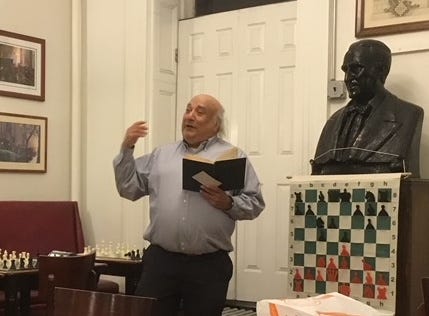
(Pictured giving a lecture in the Great Hall: Former Marshall Board member and Editor of The Marshall Swindle, Gary Forman)
The two men agreed on the scope and function of the publication and expressed it in a statement of policy, in effect their own Magna Carta: “…it will be dedicated to reporting on all aspects of the game to inform and entertain its readers. We intend to make this “magazine” of broad appeal, light and entertaining in nature but yet containing ideas that might stimulate the strength of players.”
The only aspect of the publication upon which they differed was its title. Forman wanted to call it The Marshall Swindle because, as he wrote, “it [would] represent one aspect of the game in which the founder of our Club, Frank J. Marshall, was preeminent.” Goldwater thought it should be titled something more formal. After some back and forth, and at the last minute before publication, Goldwater agreed with Forman and in April 1976, The Marshall Swindle, Volume 1, Number 1, made its way to the membership. Forman was named Editor and given free reign to solicit work from players, write his own opinions and features and take on the responsibility of getting The Swindle published as frequently as possible. Whereas members were given free copies, non-members or visitors to the Club were charged twenty five cents. Although the circulation did not grow very much outside the Club, copies found their way into the hands of other players and the comments about the content were favorable. Grandmaster Walter Browne might have been an exception: when presented with a copy by Editor Forman, he questioned how young Club members George Kane and Joseph Tamargo had gained so many rating points, which was less of a criticism of The Swindle than perhaps of the Marshall itself. The answer, of course was that both players were consumed by the game, studied hard and allowed chess to become their raison d’être. They both became Masters.
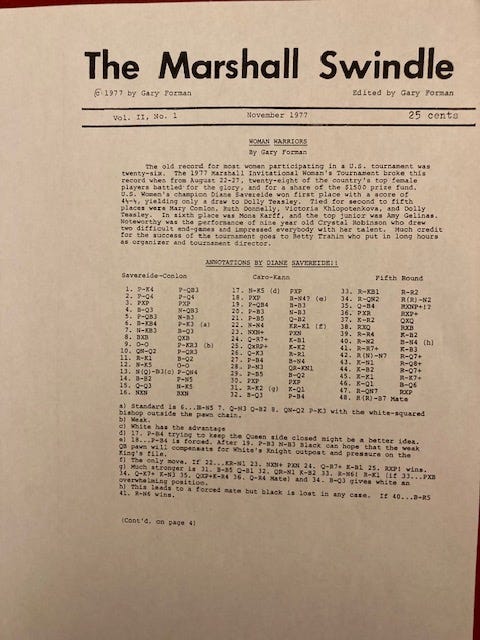
(An original copy of The Marshall Swindle, courtesy of Dr. Frank Brady)
The Marshall Swindle did not swindle. The news was lively and appropriate; the essays and articles were instructive. Members who were not present at or playing in the Marshall Invitational Speed Tournament, for example, discovered one night that Samuel Reshevsky had complained of not feeling well, and eventually passed out on the banquette where he was seated. 911, the national emergency number, was called, and Reshevsky was taken by ambulance to St. Vincent’s Hospital located just a few blocks from the Club.
He was diagnosed with a heart attack. Dr. Milton Finkelstein, the Chairman of the Board of the Club, accompanied the Grandmaster and stayed with him through the night. Reshevsky was released the next day, since the attack, although somewhat dangerous as are all heart attacks, was diagnosed as being relatively mild. Anatoly Lein, a young Soviet Grandmaster, who had arrived in the United States for the first time, won the first prize with a score of 7½-2½, ahead of such adepts as Rohde, Bisguier, Soltis and Sherwin, and other strong players.
In an hilarious article written by Virginia D’Amico, an active player and
the then future wife of National Master Asa Hoffman, wrote about women in chess, and related that she had once been paired with a French player named -- “believe it or not,” she said -- Marie Antoinette. When the round began, Antoinette was no place to be found. The Club punsters and wisecrackers had their day at the expense of Ms. D’Amico: “Oh, don’t worry about Antoinette,” said one. “She’s a piece of cake.” Or, “Your opponent must have lost her head!”
Forman included a special column, aptly called Zwischenzugs, which contained mostly news of what was going on at the Club, such as: Andy Soltis scored 10 wins and 10 draws in a clock simul against 20 experts and A players; Grandmaster Bisguier noticed that before his first game began at the weekly speed tournament he was missing a pawn. “Does anyone have an extra pawn?” he asked loudly. Milorad Boscovic volunteered and quipped: “I always save one for the endgame.”
Seventeen-year-old John Fedorowicz, known as “Fritz” and later as “Fed” to friends and insiders, had a fantastic start at the U.S. Open, overcoming a super contingent of Lombardy and Biyiasas, and drawing with Shamkovich and Denker!
For National Chess Day, October the 9th, President Gerald Ford issued a statement saying that … “Chess is a game that sharpens the mind, tests human faculties, and encourages healthy competition.” And Governor Jimmy Carter showed familiarity with chess during the first presidential debate the previous September. He accused the Ford Administration of being a “…government by stalemate.”
Also on National Chess Day, 12-year-old Joel Benjamin was invited to the Marshall to give his first simul. He scored 11-1. Joel had been playing a little over 2½ years, and had a rating of 2075; his destiny as a future Grandmaster although not pre-ordained, seemed to be on the verge of possibility.
In the November 1978 issue, President Goldwater chose to publically publish, for the first time, the latest minutes of the Board of Governors meeting, which discussed a variety of changes in the Club’s functioning:
Regular members who chose to pay for two years when they were renewing, the cost would be only $180 plus tax, saving them $21.60. Three-year renewals of $250, plus tax, would amount to a saving of $54.00.
Players rated B or lower who wish to have instruction from Masters and/or Experts can sign up for free sessions. The lessons will be broken down to openings, endings or analysis of Master games.
A visiting team from Iceland, of 20 young players, will compete against 20 Marshall juniors who will be selected by Jack Collins, Chairman of the Tournament Committee, and one of Bobby Fischer’s teachers.
In one issue, Forman took “editor’s privilege” and published a game that he won at the World Open in Philadelphia against newly minted Grandmaster Rosendo Balinas of the Phillipines. Forman’s rating was several hundred points below Balinas’s. It was not a perfect game on either player’s part but it was intriguing. After they reached the first time control Forman was two pawns ahead, but played poorly, allowing Balinas tremendous counterplay. Approaching the second time control, however, Balinas had just two minutes to Forman’s five and two unstoppable passed pawns. Balinas probably should have resigned but appeared almost to be in shock as he just stared, almost blankly, at the board until the flag fell.
Editing and publishing any periodical of worth is an intricate, difficult and time consuming operation. Forman began to feel that it took “more time and trouble” than he cared to invest in it due to his full-time professional work. Nevertheless, he said decades later, “I am sorry that I didn’t persevere.” No one could be found at the Club to replace him.
In the late 1970s, The Swindle ceased publication, each issue entering the world of collectors’ items, each vibrating with a sense of nostalgia.
This excerpt of The History of the Marshall Chess Club by Dr. Frank Brady is Copyright 2023 by the publisher, American Chess Magazine.
— Dr. Frank Brady, President Emeritus of The Marshall Chess Club
Recent Game Submissions
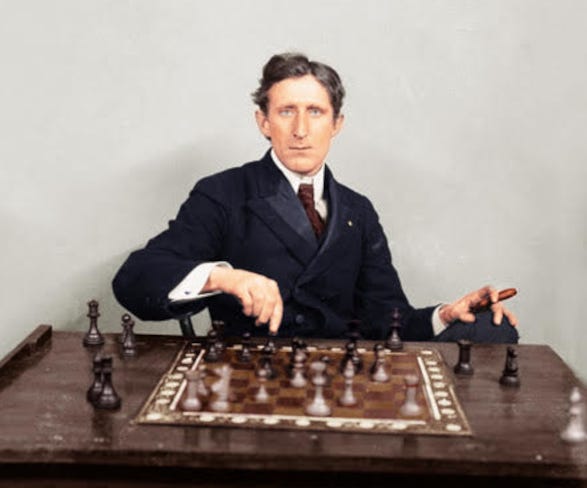
The Spectator is thrilled to continue a contest for our current members. If you have played a recent game at the Marshall Chess Club that you think may be appealing to a wider audience, please submit it with your annotations to td@mashallchessclub.org. We will select the most interesting game based both on the quality of play and annotations and publish it here for our readership to enjoy.
In this issue we feature not 1 but 2 recent games! Congratulations to Michael Li and Dylan Shlachter for submitting the best annotated, recently played games and winning a free tournament entry each.
We look forward to reading your submissions and sharing your recent brilliancies with our readership.
Li, Michael 2006 vs. Nasta, Kiren 2192
Marshall Chess Club Action May 18, 2023
(You can play through the game here.)
The annotator plays White, the other player is Black:
1. e4 e5 2. Nf3 Nc6 3. Bb5 a6 4. Ba4 Nf6 5. d3 b5 6. Bb3 Bc5 7. Bg5!? An uncommon sideline.
7... h6 My opponent played the correct move, but he was undoubtedly surprised and was already out of preparation.
8. Bh4 g5 9. Bg3 d6 10. c3 Qe7!? I had not prepared this line, but...it is very similar to other lines.

11. a4 b4!? This does appear to transpose to some other line, but the knight comes to c4 from d2-c4 rather than a3-c4.
12. a5 O-O 13. Nbd2 Bd7 14. Nc4 Nd8 15. O-O! We had delayed castling till the perfect moment, when d3-d4 cannot be stopped, and Black cannot initiate a kingside attack, his main plan in this Ruy Lopez structure.

15... Nh5 16. d4 Nxg3 17. hxg3!? (17. fxg3!? was also a choice, but during the game I had decided to play slightly safer.)
17... exd4 18. cxd4 Ba7 19. Ne3! The threat of Ne3-d5 is very real. And a variety of traps arise.

19... c6 The only move that doesn't lose. For example, 19... Qxe4? 20. Bd5 loses material, the logical but doomed. 19... Re8?? loses to 20. Nd5! and the queen has no good squares to avoid losing material again, and something like, 19... Bc6? runs into 20. Nf5! Qf6 (20... Qxe4 21. Bc2! and Black loses the queen. 21. Nh2! $18 { and Black loses again. })
20. Re1! This is immensely strong. White doesn't waste any valuable time defending the e4-pawn.
20... Ne6?? (20... Qxe4? obviously loses to 21. Nd5! and no matter where Black goes, he hangs the queen: 21... Qh7 (21... Qg4 22. Nf6+) (21... Qg6 22. Ne7+) (21... Qf5 22. Ne7+ However, the game continuation is not much better: 22. Nf6+)
21. Nf5! Taking advantage of the weakened light squares.
21... Qf6 22. Nh2!! This move is practically, much stronger than the computer line: (22. Nxd6! where White does win a pawn and have a huge advantage, but Nh2 poses much more problems.
22... Kh7 The point of Nh2 is revealed: (22... Nxd4 loses to 23. Ng4 Qd8 anywhere else hangs the queen to a knight fork 24. Ngxh6+ Kh7 25. Qh5! and mate comes very, very soon.
23. Ng4 Qg6 24. e5! Threatening the strong move Ng4-f6, which forks the bishop on d7. 24... Kh8
Of course not (24... Qxf5? 25. Bc2 $18) 25. Bc2 h5 26. Ne7 Qxc2 The only move that does not get mated immediately 27. Qxc2 hxg4 28. Qf5 Rae8 29. exd6 Black played on for 20 more moves with his bishop and knight vs queen, but eventually lost. 1-0 What a beautiful game!
James Margolis 1419 vs. Dylan Shlachter 1286
Marshall Chess Club U2000 Morning Action
(You can play through the game here.)
1. e4 e5 2. Nf3 Nc6 3. d4 exd4 4. Nxd4 Nxd4 5. Qxd4 A Scotch, which I was glad for as my previous game was too sharp for me.
5... d6 6. Bc4 Be6 Attempting a trade of bishops and castling queenside.
7. Bxe6 fxe6 accepted 8. O-O Qf6 Trying to simplify this into a game where my opponent can't win my loose pawns.
9. Qxf6 Nxf6 This was a mistake by White. Now the position is equal.
10. Nc3 O-O-O 11. f4 e5 The point of this was to either trade or give in to a draw.

12. fxe5 dxe5 13. Bg5 Be7 Stockfish says that Bc5+ is the best way to keep adding pressure.
14. Rad1 h6 15. Bh4 g5 16. Bg3 Ng4 17. Rxd8+ Rxd8 18. Nd5 My only move here is to check with Bc5+.
18...Bc5+ 19. Kh1 h5 This gives up my momentum. I should have played c6 to kick out White's knight.
20. h3 Ne3 21. Nxe3 Bxe3 22. Bxe5 Not winning because of Re8 and Rd2.
22... Re8 23. Rf5 h4 Closing out most of the king's escape squares.
24. Kh2 Here, I missed the brilliant Rxe5. That would've won the game on the spot.
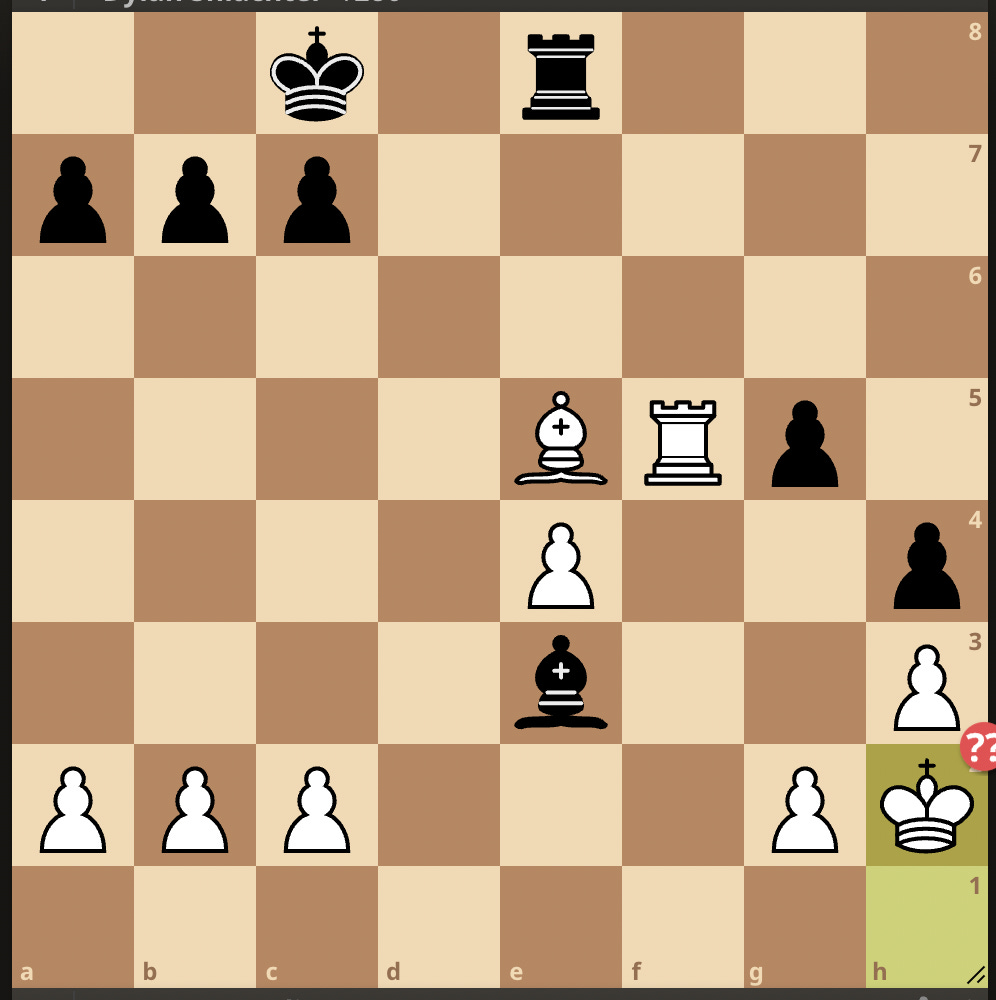
24... Rd8 25. Bf6 Threatening the rook. 25... Rd1 This threatens a mate in 3, it also threatens a repetition as I am down a pawn and a draw would be helpful too.
26. Bxg5 Mate is now unavoidable. (26. Rd5 Bg1+) (26. g4 Rd2+) 26... Bg1+ 27. Kh1 Bf2+ My opponent shakes his head now. He knows it's over.
28. Kh2 Bg3# 0-1
Chess Toons

En Passant
– GM Magnus Carlsen and GM Jan-Krzysztof Duda fought a memorable and thrilling final round of the Superbet Poland Rapid & Blitz 2023, where the former held his nerve to hold a draw and win the event with a score of 24 points and pocket the top prize of $40,000 and 13 Grand Chess Tour points. Duda finished second with 23 points for $30,000 and 10 GCT points, while GM Wesley So and GM Maxime Vachier-Lagrave tied for third and fourth places with 21.5 points to pocket $22,500 and 7.5 GCT each.
– Nodirbek Abdusattorov beat Fabiano Caruana 2½-1½ to win the ChessKid Cup, the third event of the 2023 Champions Chess Tour. It was a hard-fought Grand Final match, which saw Abdusattorov beating Caruana for a second time in the tournament.
– Carlsen lost to a Pole in Poland with the Polish Defence.
Problem of the Week
G. Hume (after J. Bunting), 1924

White to mate in 2.
Do you have friends with the initial "K"? How about "R"? Or maybe "P"? Or "F"? Or "D"!?? If so, this problem is for them. If you know someone with all those initials, suggest this as a tattoo.
----------------
A. O. Herbstman, 1934

White to move
Solution to A. O. Herbstman, 1934: 1.Bh7+ Kxh7 2.exf8=N+ and White wins. If 1...Kg7 2.exf8=B+ (not 2.exf8=Q+, which leads to stalemate!). And if 1...Kh8 then exf8=R+. Three - count 'em, 3! - underpromotions.
- Puzzle submission by Alexander George, Marshall Chess Club Member
Editor's Note
As always, if you have any feedback, comments, or would like to submit an article please contact us directly at td@marshallchessclub.org.
Enjoy, and thanks for reading!
The Marshall Chess Club
Address: 23 West Tenth Street New York, NY 10011
Contact: 212.477.3716; td@marshallchessclub.org
Hours: Monday 1pm-Midnight; Tuesday - Closed, Weds-Fri 1pm-Midnight; Sat/Sun 9am-Midnight



